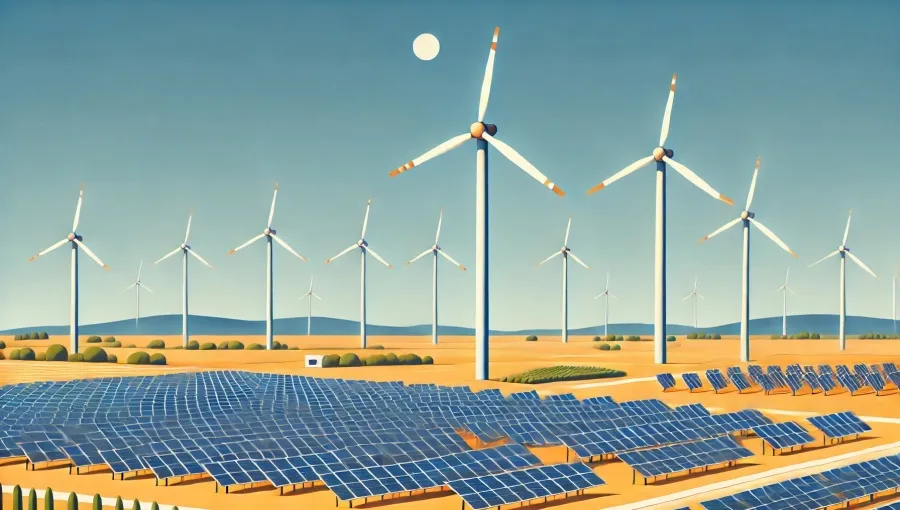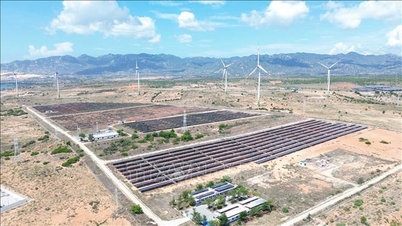Global renewable electricity output hits record
For the first time in history, renewable energy has surpassed coal to become the largest source of electricity generation. The world is entering a period of energy abundance. If three years ago, when the Ukraine-Russia conflict broke out, people talked a lot about energy crises, now the world is entering a period of transition from energy scarcity to energy abundance. This is the latest assessment recently made by Rystad Energy - a leading independent energy research and information company in the world.
For the first time, global renewable energy production, including wind and solar, has surpassed coal. The report shows that global solar capacity increased by a record 31% in the first half of the year, while wind increased by 7.7%. Combined solar and wind power production increased by more than 400 TWh - more than the increase in total global electricity demand in the same period.
“In the first half of 2025, we saw solar and wind power outpacing electricity demand growth. Coal generation is falling in China and India, and so are emissions, and these are economies with fast-growing demand. We can expect the growth of coal power to end soon,” said Malgorzata Wiatros-Motyka, Senior Grid Expert, Ember Group.

Renewable energy is expected to meet up to 90% of global electricity consumption growth this year.
Solar energy becomes the main source of electricity in the EU for the first time
Renewable energy is expected to meet up to 90% of global electricity consumption growth this year, even as billions of kilowatt-hours of data centers are still being built.
In the European Union EU, in the second quarter, more than half of the net electricity generated also came from renewable energy sources.
According to Eurostat data, June was the first month in history in which solar power was the main source of electricity generated in the EU, accounting for a fifth of the energy mix. This was followed by nuclear, wind, hydro and natural gas. Thus, electricity from fossil fuels has all but disappeared in Europe.
China actively promotes renewable energy
As for China, despite some slowdowns due to policy changes, the country is still expected to continue to lead the world in renewable energy growth, accounting for about 60% of new capacity additions globally.
According to the IEA, the current momentum of technological innovation in China can help the country achieve its 2035 wind and solar power target five years earlier. This breakthrough also promises to bring many benefits to consumers in the country of one billion people.
China's advantage in renewable energy comes from its superiority in investment and technological innovation. Last year, investment in key renewable energy projects accounted for more than 80% of China's total power investment. Technological innovation - especially in the fields of photovoltaics and wind turbines - has continuously improved conversion efficiency, making solar and wind power in China increasingly stable, efficient and cheaper, increasing its share in the national power system.
The positive impacts can be seen most clearly in the Xinjiang Uyghur Autonomous Region, where more than 60% of grid capacity comes from renewable energy.
Mr. Feng Xiaoheng - Operation Director of Ha Mat Solar Power Project, Xinjiang Autonomous Region, China shared: "Our solar power project helps increase daily electricity output this year to 1.12 million kWh and can meet the electricity needs of about 200,000 households."
In addition, renewable energy also brings other benefits to the local economy, such as increasing job opportunities and improving people's income.
Mr. Li Yongxiang - Renewable Energy Project Manager, Xinjiang Uygur Autonomous Region, China commented: “Our renewable energy project has created many jobs for local people. Initially, we set up a vocational training school for more than 4,000 participants, including farmers and herders. Most of them were employed after completing the training, which greatly improved their income and promoted local small businesses.”

Tapping into surplus electricity is becoming a more viable way to produce cheap hydrogen fuel.
Japan deploys solution to reduce hydrogen fuel cost
In today's energy-abundant era, even surplus solar energy is being used to produce hydrogen fuel at the cheapest cost, aiming to commercialize this strategic carbon-neutral fuel.
Hydrogen fuel is produced using clean energies such as excess solar energy, so hydrogen can be produced at a cheaper cost and can be competitive in the market.
Tapping into surplus electricity is becoming a more viable way to produce cheap hydrogen fuel. The company is also building pipelines to deliver hydrogen fuel to areas where it is used.
Mr. Yasumitsu Okazaki - Head of Hydrogen Development Team, Hokkaido Electric Power Company, Japan said: "Hydrogen production equipment is quite expensive and operating costs are high, so we are looking for ways to reduce equipment costs. I think it is necessary to develop technology such as extending the life of equipment and operators to make efforts to reduce costs."
In Japan, hydrogen fuel is being subsidized by the government at about 700 Yen (about 12,000 VND) per kilogram to compete with traditional fuels such as gasoline and oil. Reducing the cost of hydrogen fuel will be an important condition for Japan to move towards a hydrogen society.
Source: https://vtv.vn/thoi-ky-doi-dao-nang-luong-100251011120800677.htm




![[Photo] Discover unique experiences at the first World Cultural Festival](https://vphoto.vietnam.vn/thumb/1200x675/vietnam/resource/IMAGE/2025/10/11/1760198064937_le-hoi-van-hoa-4199-3623-jpg.webp)






























![[Photo] General Secretary attends the parade to celebrate the 80th anniversary of the founding of the Korean Workers' Party](https://vphoto.vietnam.vn/thumb/1200x675/vietnam/resource/IMAGE/2025/10/11/1760150039564_vna-potal-tong-bi-thu-du-le-duyet-binh-ky-niem-80-nam-thanh-lap-dang-lao-dong-trieu-tien-8331994-jpg.webp)





































































Comment (0)